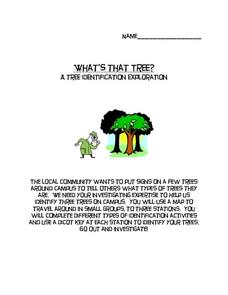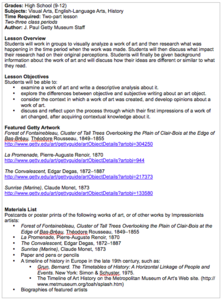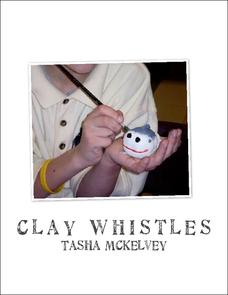Curated OER
Real Misleading Graphs
Students identify real graphs and misleading graphs. For this algebra lesson, students surf the Internet for real life scenarios where graphs are used in a misleading way as well as in a correct way.
Curated OER
Using Fractions to Represent M&M Colors
Students investigate the concept of fraction and tangible application. In this algebra lesson plan, students use fractions to solve real life scenarios. They convert between fractions and decimals and identify the numerator and denominator.
Curated OER
Using Proportions to Estimate
Students calculate ratio and proportion. In this unit rates lesson, students estimate using proportions and find their errors in doing so. They calculate unit rates and define the concept of unit rates.
Curated OER
Weigh Out the Algebra
Students solve linear equations. In this algebra lesson, students use manipulative's to see the steps taken when solving linear equations. They solve using addition, subtraction, multiplication and division.
Curated OER
The Mysterious Tragedy at Lake Nyos
Students present a convincing explanation of the Lake Nyos event and propose a solution to prevent future tragedies at central and western African lakes.
Curated OER
What's That Tree?
Fifth graders identify trees along a nature trail. Using a dichotomous key, 5th graders answer questions to aid in their identification of trees along a specified nature trail. Observations are recorded in their science journals. Sample...
Curated OER
Bud, Not Buddy
Fifth graders read the book Bud, Not Buddy and participate in activities that generate understanding of the Great Depression. In this realistic fiction instructional activity, 5th graders read about a boy who grew up during this time....
Curated OER
Repopulating Michigan's Waterways
Eleventh graders identify the parts of an ecosystem and how communities change over time. In this ecology lesson students formulate a habitat restoration plan.
Curated OER
Marine Protected Areas (MPA)
Ninth graders explain the purpose of MPA's. In this biology lesson, 9th graders identify MPA's in Southern California. They simulate coastal sampling using candy from two buckets. Students analyze their results and share it with the class.
Curated OER
American Revolution Vocabulary Cartoons (art)
Fifth graders discuss cartoons. In this art lesson, 5th graders make their own cartoon using vocabulary words from the American Revolution.
Environmental Protection Agency (EPA)
The Case of the Mysterious Renters
Upper-elementary kids examine the water usage in their own home, then use that data to solve a case in which a landlady is trying to determine how many people are living in an apartment being rented. Combine math, scientific method, and...
Polk County Public Schools
Suffragists
The Women's Rights movement is the focus of an engaging and collaborative exercise, in which young historians use information found in textbooks, class notes, and the provided documents to craft a DBQ essay.
J. Paul Getty Trust
Historical Context: Discovering a Painting
Class members are presented with the image of a painting and asked to record their first impressions and analysis. They then research the time period in which it was painted and discuss how their research impacted their first impression...
Curated OER
Working in your Cubicle: Critical Thinking and Writing
Explore informative and explanatory writing with this lesson. Using a cube labeled with directives to describe, analyze, compare, associate, apply, and argue the topic, middle schoolers work individually or in groups to answer questions....
Earth Watch Institute
Entering Local Groundhog Data in an Excel Spreadsheet
Here is a cross-curricular ecology and technology instructional activity; your learners create spreadsheets depicting the location and number of groundhog dens in a local park. They research groundhogs and analyze data about where the...
Curated OER
Synonym Trees
Pair learners to define synonyms. They search flash cards to find a synonym partner. Then they chart pairs of synonyms on a synonym tree.
United Nations
Compost Monitor Training
What should go in the trash, and what can be composted? Guide your young conservationists through the process of composing their trash with a lesson about the different ways we can dispose of garbage. Using a trash bag with clean...
Tasha McKelvey
Clay Whistles
Create clay whistles with your elementary or middle school young scholars. The project is outlined in great detail here, complete with step-by-step photographs, finished examples, a materials list, student handouts, and a rubric....
University of Wisconsin
Analyzing Presidential Campaign Propaganda
Campaign propaganda has evolved from 1952 through the presidential election of 2008. A social studies activity prompts class members to analyze the devices used in ads and political cartoons, noting strategies they believe would work to...
Curated OER
Harriet The Spy
Fourth graders investigate the style of diary writing as its own genre of literature. They read Harriet The Spy in order to have a text for this literature study. Students use the skill of prediction to preview the story, and then...
Curated OER
"Julie of the Wolves"
Fifth graders research life in Alaska and compare life there to their lives in this instructional activity. They read "Julie of the Wolves." They research through the novel and other reference books facts about the Alaskan climate and...
Curated OER
Stone Fox Plot Frame
Fifth graders recall the major plot points of a chapter book. After reading the chapter book "Stone Fox," they students describe the plot framework through use of a worksheet. Students are then divided into group to act out selected...
Curated OER
At the Crossroads
Third graders explore where South Africa is and then research details about the country to fully assess the background to the book, "At the Crossroads." They receive a map of Africa and color in the country of South Africa and list five...
Curated OER
Surface Area with Polydrons
Students explore measurements by analyzing geometric shapes. In this surface area lesson, students identify the terms volume, weight, perimeter and area in order to find the requested measurements of specific polygons. Students utilize...

























